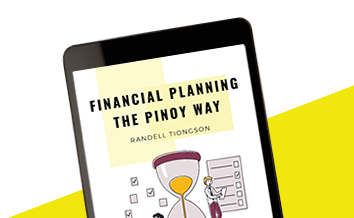Tag: randell tiongson
Is he a real financial planner, part 2
By Randell Tiongson on February 21st, 2010… con’t.
2. Gathering client data, including goals.
The financial planner should ask for information about your financial situation. You and the planner should mutually define your personal and financial goals, understand your time frame for results and discuss, if relevant, how you feel about risk. The financial planner should gather all the necessary documents before giving you the advice you need.
3. Analyzing and evaluating your financial status.
The financial planner should analyze your information to assess your current situation and determine what you must do to meet your goals. Depending on what services you have asked for, this could include analyzing your assets, liabilities and cash flow, current insurance coverage, investments or tax strategies.
4. Developing and presenting financial planning recommendations and/or alternatives.
The financial planner should offer financial planning recommendations that address your goals, based on the information you provide. The planner should go over the recommendations with you to help you understand them so that you can make informed decisions. The planner should also listen to your concerns and revise the recommendations as appropriate.
5. Implementing the financial planning recommendations.
You and the planner should agree on how the recommendations will be carried out. The planner may carry out the recommendations or serve as your “coach,” coordinating the whole process with you and other professionals such as attorneys or stockbrokers.
6. Monitoring the financial planning recommendations.
You and the planner should agree on who will monitor your progress towards your goals. If the planner is in charge of the process, she should report to you periodically to review your situation and adjust the recommendations, if needed, as your life changes.
In the Philippines, the leading organization for Financial Planner certification is probably the Registered Financial Planner Institute, a local chapter from Ohio, U.S.A. There are about 400+ individuals who have taken the program since its inception in 2005 in the Philippines. The program boasts of several comprehensive programs on Financial Planning, Investment Planning, Insurance Planning, Estate Planning and more. The local chapter also boasts of several well respected and credentialed moderators who are University Professors, Columnists, Best-Selling Authors, Corporate Executives, etc.
It is always best to check out your financial planner. Is he credible? Does he have the credentials? Does he have the necessary experience? And more importantly, does he have the right character as trust is the most important foundation in a planner-client relationship.
Be careful in choosing a financial planner but don’t dilly-dally in getting one, it really is a wise decision to make.
“The wisdom of the prudent is to give thought to their ways, but the folly of fools is deception.” – Proverbs 14:8, NIV
Is diversification rocket science?
By Randell Tiongson on February 10th, 2010Appeared at the Business Mirror, 02.08.2010
 You often hear the word “diversification” when investments are discussed. Diversification is important; in fact, it is considered one of the most effective risk-management tools, minimizing investment losses.
You often hear the word “diversification” when investments are discussed. Diversification is important; in fact, it is considered one of the most effective risk-management tools, minimizing investment losses.
What does Investopedia (a favorite online site for investment stuff) say about diversification?
“A risk-management technique that mixes a wide variety of investments within a portfolio. The rationale behind this technique contends that a portfolio of different kinds of investments will, on average, yield higher returns and pose a lower risk than any individual investment found within the portfolio.
“Diversification strives to smooth out unsystematic risk events in a portfolio so that the positive performance of some investments will neutralize the negative performance of others. Therefore, the benefits of diversification will hold only if the securities in the portfolio are not perfectly correlated.”
Diversification is often misunderstood and its execution has always been a mystery to many. To many of us, diversification is just putting your money in different banks or buying different pieces of property in different areas. However, diversification is much more than that and here are some ways to diversify:
1) By asset class—Cash or near cash (savings or checking accounts, time deposits, treasury bills or money market accounts); fixed income (government securities, corporate bonds); equities (stocks); real estate; collectibles (paintings, jewelry, etc.); enterprise (business)
2) By time frame—short term (about a year); medium term (up to about five to seven years); long term (over seven years)
3) By risk—conservative, moderate, high or speculative
4) By liquidity—highly liquid vs. nonliquid
Above are just a few ways to consider classifying your assets/investments regarding diversification. Here are some diversification tips: vary your asset classes; combine short-, medium- and long-term investments; combine highly liquid and nonliquid assets.
By practicing diversification, you are also practicing sound risk management. A properly constructed diversification strategy will minimize the risks of your investments and, at the same time, give you better yields as compared with taking an ultra-conservative position. With a good diversified portfolio, the risk of totally wiping out your wealth is highly unlikely, but at the same time, allow you to experience better growth which will be more than inflation.
But diversification also has its downside. Sometimes, a portfolio that is too diversified can also prevent you from earning properly, as the volatility of many of the players in your portfolio can cancel each other. However, having a very risk-averse position can be just as dangerous as taking a risky option, as inflation can erode the value of your wealth. The more prudent option then would be to learn diversification.
Do not be too afraid to try out diversification, it is not rocket science. Come up with a diversified program that is consistent with your investment objective, risk tolerance and time frame and you are on the road to achieving financial peace.
I really like the way the Bible talks about diversification. Yes, the Bible is a good source of investment wisdom and here’s proof: “But divide your investments among many places, for you do not know what risks might lie ahead.”—Ecclesiastes 11:2 (New Living Translation)
Since the Bible advocates diversification, I am assured that it’s a great idea.

